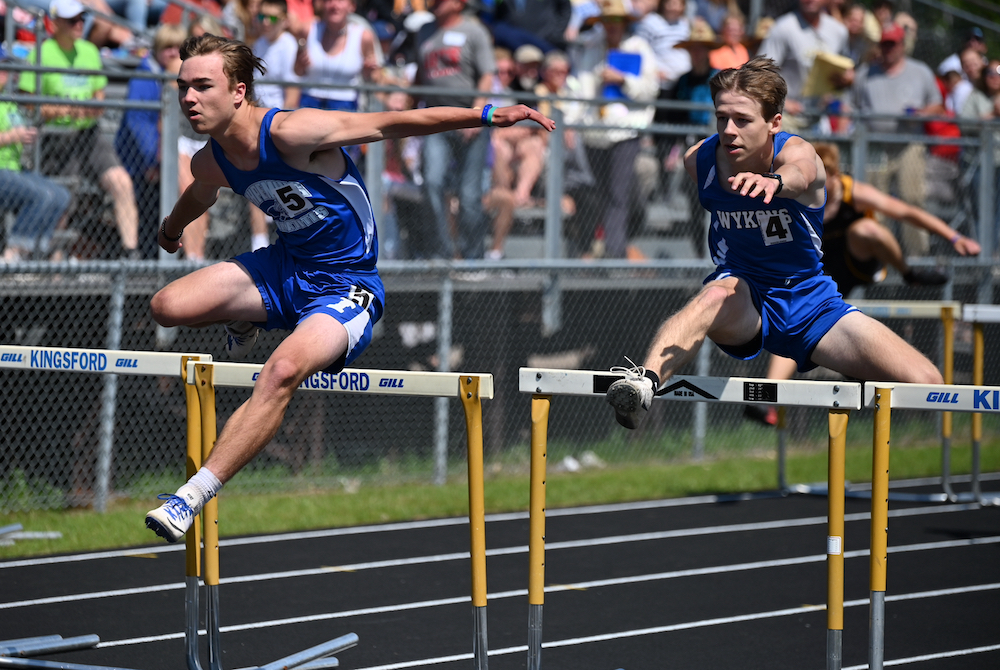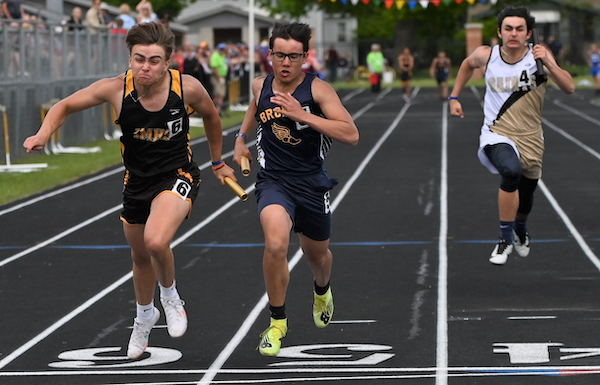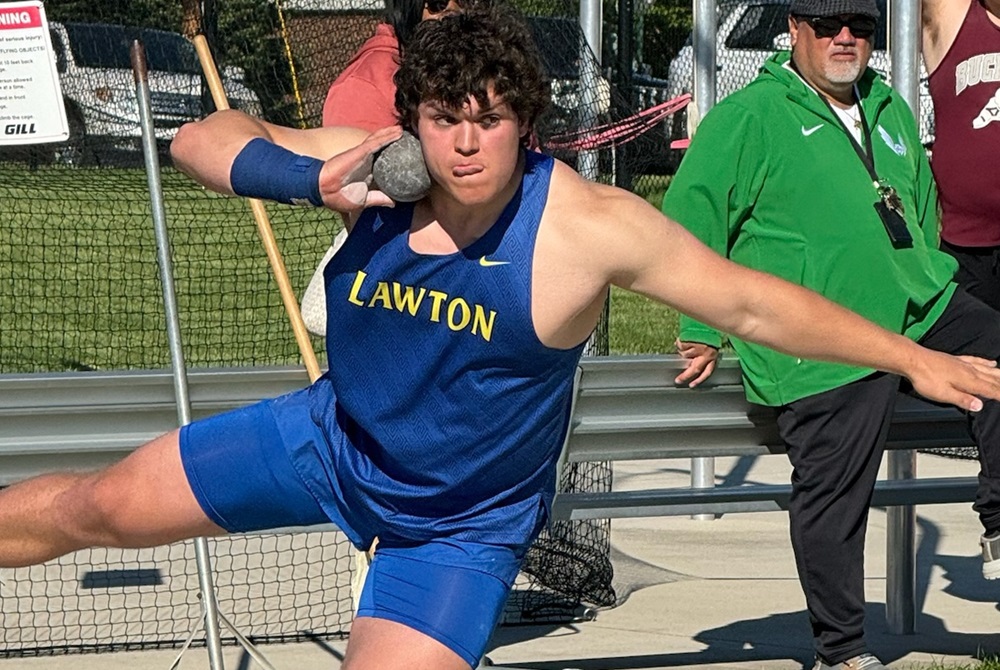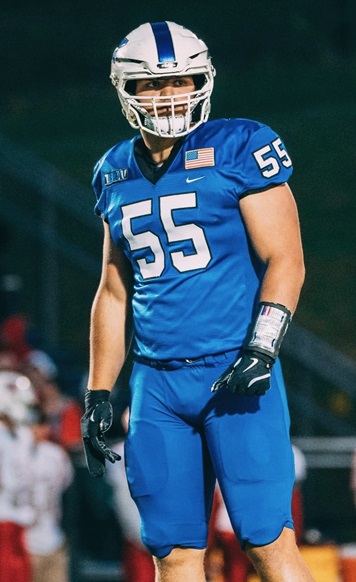
Ishpeming Adds to Near-Decade Reign Atop Upper Peninsula Division 2
By
John Vrancic
Special for MHSAA.com
June 5, 2022
KINGSFORD — The Ishpeming boys have allowed very little to stand between them and the Upper Peninsula Division 2 track & field championship in recent years.
They added another trophy to their collection Saturday by scoring 116 points.
The Hematites, who won three of the last four titles outright and shared the fourth, were followed by Iron Mountain with 102 points and St. Ignace at 63.
Senior Jonny Matson scored 36 points for the Hematites, who also have either won or tied for the title six of the last seven seasons.
That string was interrupted only in 2017 when they were runners-up to Newberry and three years later by COVID-19.
Last year, the Hematites shared the title with Norway.
Matson won the 400-meter dash in 53.58 seconds and long jump at 18 feet, 11¾ inches and was runner-up in the 100 (11.73) and 200 (23.77).
“Jon has been a great leader for us, and Parker Gauthier and Hunter Smith picked it up,” said Troy Smith, who shares Ishpeming’s coaching duties with his wife Trisha. “We greatly appreciate the effort of our coaching staff (Morgan Kangas, Khora Swanson and Hailey Smith). They’re a big part of our success.
“Our numbers have been a little low, but we have a great group of kids.”
 The Hematites won the 3,200-meter relay in 9 minutes, 4.42 seconds, and Tramon Gauthier added a first in the 110 hurdles (16.67) and second in the 300s (43.0).
The Hematites won the 3,200-meter relay in 9 minutes, 4.42 seconds, and Tramon Gauthier added a first in the 110 hurdles (16.67) and second in the 300s (43.0).
Smith was runner-up in high jump (5-11), and Parker Gauthier placed third in the 3,200 (11:44.6).
Iron Mountain’s Matt Colavechhi won the 100 (11.56) and 200 (23.71), and senior Luke Ruble added victories in the 1,600 (4:54.69) and 3,200 (10:52.05).
The Mountaineers also won the 400 relay (45.31) and 800 (1:34.42).
Bark River-Harris was runner-up in the 400 in a school-record 45.34
“Nick (Anderson) started real good and got us in a good spot,” said BR-H junior Vincent Martin, who ran the second leg. “We were seeded fourth. We knew the other three teams were good in the first and anchor legs. We mixed up our lineup a little and were in first going into the third leg.”
St. Ignace got a first from junior Reese McLean in the 800 (2:09.06), and Owen Lester took pole vault (10-0).
“That was a PR by three seconds,” said McLean. ‘With this being the last meet, I decided I might as well put everything into it. I think I started out all right. I wanted to get to the front right away.”
West Iron County’s Landon Sundelius won the 300 hurdles (40.56) and placed second in the 110s (16.74), and Nathan Hochstein of L’Anse was high jump champion at 5-11.
Manistique earned a victory in the 1,600 relay (3:43.99).
PHOTOS (Top) Ishpeming's Tramon Gauthier leads West Iron County's Landon Sundelius and they take first and second in the 110 hurdles. (Middle) Iron Mountain's Matthew Colavecchi edges Bark River-Harris's Vincent Martin by three hundredths of a second to seal the win in the 400 relay. Other members of Iron Mountain's winning relay were Max Jayne, Joey Colavecchi, and Kurt Adiano Ryan. (Click for more from Cara Kamps/Run Michigan.)

Football Future Awaits, but Mayne Focused First on Finishing Track Finals Sweep
By
Pam Shebest
Special for MHSAA.com
April 22, 2025
LAWTON — One inch. One lousy inch.
 That was the difference between a championship and second place for Mason Mayne in the shot put at last year’s MHSAA Lower Peninsula Division 3 Track & Field Finals.
That was the difference between a championship and second place for Mason Mayne in the shot put at last year’s MHSAA Lower Peninsula Division 3 Track & Field Finals.
One year later, it is still fresh in the mind of the personable Lawton senior as he begins his quest for more hardware.
“That one hurt,” said Mayne, whose best attempt finished second to a 60-foot, 2-inch toss by Pewamo-Westphalia’s Gavin Nurenberg.
“That really burned. You start to wonder, did they measure it wrong? What if I just literally put a little more into it? It drove me to work harder toward it.”
That harder work paid off during the second event that day as Mayne defeated the then-senior Nurenberg 166-6 to 165-11 in the discus to claim Lawton’s first-ever track & field state championship in that event.
Besides taking home that Finals title last year, Mayne holds school records with an indoor-season shot of 62-6 and outdoor of 60-9, as well as a discus toss of 178 feet.
An all-state football player and outstanding student as well, Mayne had opportunities to continue his athletic careers in both sports before signing with Northwestern University. But he also made the decision to compete for his high school one more time this spring instead of graduating early to begin his college career – much to the delight of Lawton track & field coach Mike Meyer.
“He’s been nothing but a joy ever since his freshman year,” Meyer said. “He’s a good, hard worker, obviously a great athlete. All his talent is definitely a nice problem to have.
“He’s been a two-year captain for us, so a good leader, (he) does everything and more than what we ask. That’s why he has the success that he has.”
All-around talent
Mayne said coaching is one big crossover from football to track & field.
“Listening to someone tell you what to do and then do it, I think that’s a super big part of throwing,” he said. “If someone tells you how to do something better in your throw to make it technically better, and you can’t do it, then you can’t get better.
“Playing football for so long, I’ve had so many coaches tell me to do this just a little bit different. And being able to flip that and make that change and adjustment, that’s what makes me able to get better at throwing.”
Mayne said hurling the disc takes more finesse than the shot.
“Technical-wise, the shot put (12 pounds) is easier because I can base it more on how much muscle I can put into it,” he said. “Discus is lighter, (3.5 pounds) but you also have to use your technique a lot more.
“Also, you have to push your body to a point of really stretching it back, allowing it to create a lot of torque into the disc to be able to throw it far enough for it to be worth anything.”
As for those windy days competing in field events, “A lot of people think that the wind behind you helps you,” Mayne said. “That’s actually not true.
“It actually bats the disc down. In the discus, as a right-handed thrower, you want the wind to come across a little bit from your left to throw into. Think of it as an airplane wing, holding up the airplane, the air coming into it. With the shot, it doesn’t matter. It’s just throwing it.”
Lawton’s athletes who specialize in field events also compete in some running competition. Mayne has run the 200 this season and took a turn running the 100 last spring as well.
 “We usually have our throwers run the 200,” Meyer said. “We like athletes instead of just specializing in just one or two things for the (Southwest Athletic) Conference.
“We usually have our throwers run the 200,” Meyer said. “We like athletes instead of just specializing in just one or two things for the (Southwest Athletic) Conference.
“We have all of our kids run two, three and sometimes four events. It can be a long day at a track meet if your events are done and you have nothing to do.”
Mayne is not only an accomplished athlete, but carries a 4.19 grade-point average.
“With the way my mom (Pat) raised me and my brother (Carter) both, she’s a teacher at Paw Paw in the elementary,” he said. “She raised us with the idea that academics are very important. That’s where I’m academically driven.
“She might get mad at me for saying this, but if I miss an assignment, I’m getting a picture on my phone with a circle around it of the assignment missing in my grade book. It’s very important to me.”
That emphasis motivates Mayne’s advice for freshmen who play sports.
“Stay on top of (academics),” he said. “For so many years my mom kept me on top of things. Now I’m able to stay on top of things better myself.
“Your freshman year is the make-or-break it. Having an older brother helped a lot because without him, he wouldn’t have told me that and I wouldn’t have stayed ahead of it.”
Tough decisions
Mayne’s outstanding performances in throwing events last year attracted several college scholarship offers for track in addition to several he’d received previously for football. Choosing a college was not an easy decision for the defensive lineman, who is a two-time Kalamazoo Gazette Dream Team selection in that sport.
“It’s funny because I was really, really considering track for a while,” said the 6-foot-3, 275-pound Mayne. “After my sophomore year when I had a very successful track season, I started to lean toward track.”
 But a trip to the Big House to watch University of Michigan play tilted the scale to football.
But a trip to the Big House to watch University of Michigan play tilted the scale to football.
“I was watching and I realized I just couldn’t give it up,” he said. “I love both sports, but something about football, the team atmosphere, just sitting in the stadium gets me antsy, that atmosphere and that vibe. That’s really what flipped me into the football aspect. That electricity from the fans and the guys around you. I haven’t experienced any other sport like it.
“It was a very tough decision. I was sad that I couldn’t go multiple ways. Many fantastic coaches recruited me. It’s unfortunate that you have to tell coaches you can’t go to their program because you’re choosing a different program.”
Mayne said he had specific criteria in mind when choosing a college. “Academics is a priority here,” he said. “I also want to play football at a very high level, and then the last is a family aspect.
“Northwestern just checked all the boxes.”
Before the season, Meyer thought he might lose Mayne to early graduation since “he’s a very, very good student. We chatted and he said, ‘Coach, I definitely want to be throwing. I love throwing,’ and he’s a man of his word.
“Once he told me that, I was more excited for the season.”
At one point, Mayne did indeed consider leaving high school to enroll early at Northwestern, which would have meant missing his final spring throwing season.
However, “my mom wasn’t ready for me to leave, which I’m fine with,” he said. “I understand that. I’m her youngest child, I get it.
“Also, you get to start throwing indoors and it’s like, ‘I don’t want to give this up, either.’”
 Pam Shebest served as a sportswriter at the Kalamazoo Gazette from 1985-2009 after 11 years part-time with the Gazette while teaching French and English at White Pigeon High School. She can be reached at pamkzoo@aol.com with story ideas for Calhoun, Kalamazoo and Van Buren counties.
Pam Shebest served as a sportswriter at the Kalamazoo Gazette from 1985-2009 after 11 years part-time with the Gazette while teaching French and English at White Pigeon High School. She can be reached at pamkzoo@aol.com with story ideas for Calhoun, Kalamazoo and Van Buren counties.
PHOTOS (Top) Lawton’s Mason Mayne begins to unwind while throwing the shot during a meet. (Middle) Lawton track & field coach Mike Meyer. (Below) Mayne stands tall on the football field. (Action photos courtesy of Mason Mayne; headshot by Pam Shebest.)

